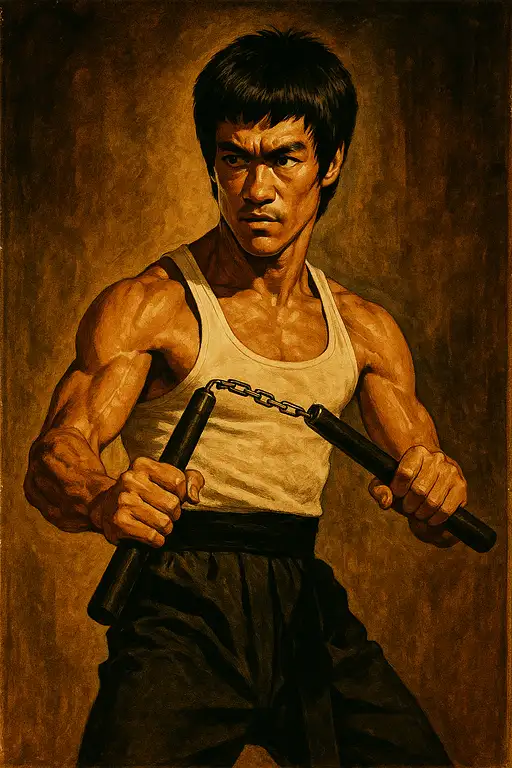


4 months ago
Create an AI-generated illustration depicting a rugged, weathered shark hunter portrayed by Robert Shaw. in the image, the character stands at the bow of his boat, intensely scanning the ocean for any sign of the shark. The illustration should capture the essence and aesthetic of 1970s films, as well as the broader cinematic style of that decade, key elements to include : the character should be prominently featured, embodying the rugged, weathered appearance of a seasoned shark hunter. His facial expression should reflect determination and focus, the scene is set on a fishing boat, with the character positioned at the bow. The ocean should stretch out before him, with subtle hints of the vast, mysterious underwater world, use lighting techniques reminiscent of 1970s cinematography, with a slightly grainy texture and warm, natural tones. The atmosphere should evoke a sense of suspense and anticipation, the illustration should mimic the visual style of 1970s films, characterized by realistic yet slightly stylized elements, with attention to the practical effects and color palette typical of that era, include subtle details such as fishing equipment, the character's distinctive attire, and any iconic elements that enhance the authenticity of the scene, the overall composition should pay homage to the classic film style while capturing the intensity and drama of the character's quest
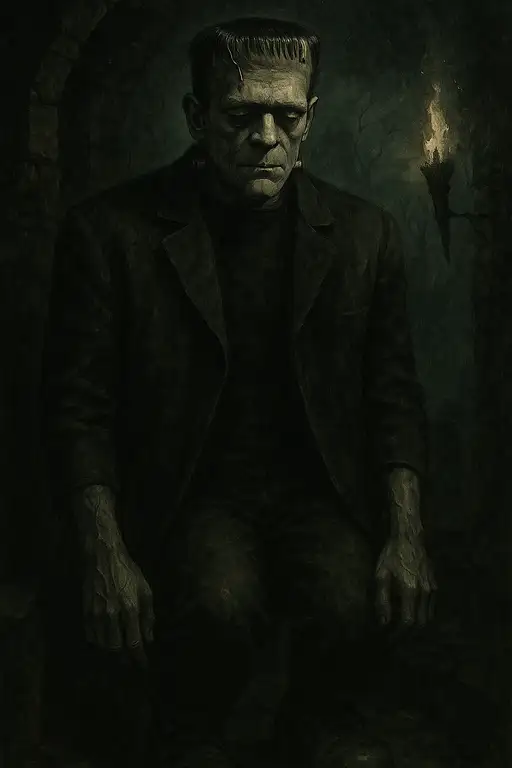
4 months ago
Create a detailed and evocative illustration of the Frankenstein creature as portrayed by Boris Karloff in the iconic 1931 film directed by James Whale. The scene should capture the essence of the classic 1930s horror aesthetic with a dark and eerie atmosphere. Emphasize the haunting and melancholic mood, evoking a sense of deep sadness and nostalgia. The creature should be depicted with meticulous attention to Boris Karloff's iconic makeup and costume, including the flat-topped head, neck electrodes, and heavy boots. Use a muted, somber color palette dominated by shades of black, gray, and muted greens to enhance the gloomy ambiance. The background should feature gothic elements such as a decaying laboratory or a misty graveyard, illuminated by the faint, flickering light of torches or candles. The overall composition should reflect the tragic and lonely existence of the creature, highlighting the emotional depth and timeless appeal of this classic horror character
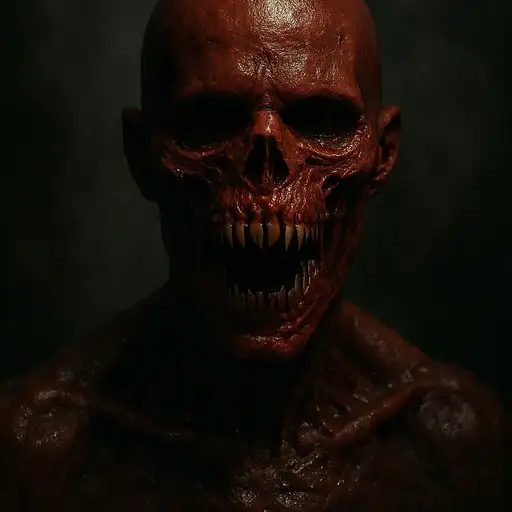
4 months ago
a highly detailed, hyper-realistic red hot ketchup horror portrait of a terrifying humanoid creature. The figure has no visible eyes, a smooth, bald head, and an unnaturally large, gaping mouth filled with long, sharp, uneven teeth. The mouth area is grotesquely deformed, with torn, rotting, and wet flesh textures that blend into the lower face. The skin is rough, scarred, and slick with an oily, decayed texture. The creature's shoulders and upper torso are emaciated and sinewy, appearing almost skeletal with stretched, wrinkled skin. The atmosphere is dimly lit with high contrast, casting deep shadows across its form. Use a moody, cinematic lighting style reminiscent of classic horror photography. The expression should evoke fear, dread, and unnatural stillness. The background is abstract and foggy to keep the focus on the creature. Composition: portrait orientation, subject centered
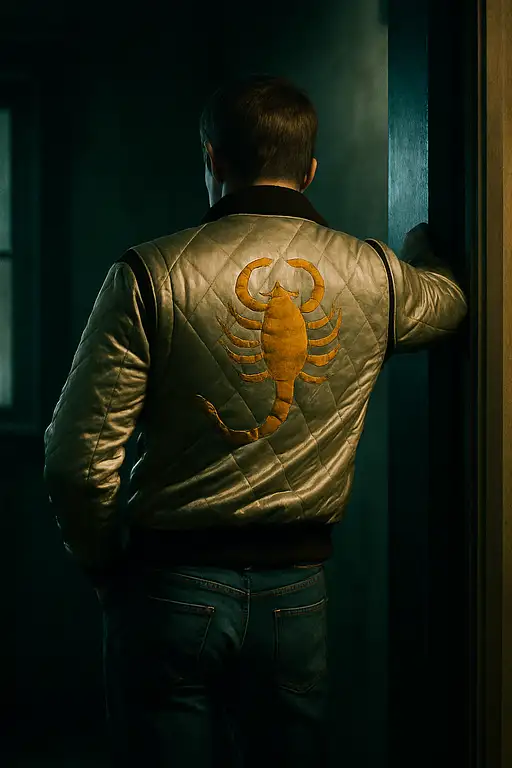
4 months ago
Create a cinematic illustration of a man seen from behind, leaning against a doorframe. He is dressed in a pair of classic blue jeans and a short, quilted silver jacket. On the back of the jacket, there is an intricately embroidered yellow scorpion, adding a striking detail to his attire. The overall style of the image should evoke the aesthetic of a thriller from the early 2000s, with dramatic lighting and a moody atmosphere. The scene should exude a strong sense of nostalgia, capturing the essence of that era's cinematic tension and emotion. The composition should be visually engaging, with a focus on the man's posture and the details of his jacket, emphasizing the scorpion embroidery as a key element. The color palette should include muted tones with the silver jacket and yellow scorpion standing out prominently. The lighting should be cinematic, with shadows and highlights that enhance the overall mood and depth of the image

5 months ago
A photorealistic, artistic image, maintaining the overall dark and moody composition. The central focus is a (singular, glistening, detailed Spider-Man web:1.4), meticulously (spun from distinct spider silk threads to clearly and legibly form the word "STOP" in capital letters:1.8). This web, (forming the word "STOP":1.7), is suspended in mid-air within a (narrow, rain-slicked, very dark and shadowy urban alleyway at night with a clear perspective showing its depth:1.3). To the left side of the alley, nestled against a shadowy wall and slightly in the foreground, stands a (classic red fire hydrant:1.3), its deep red color discernible. The (individual strands and threads making up the letters of "STOP" on the web:1.5) emit a (subtle but clear, faint rainbow-colored luminescence or iridescent glow:1.6), serving as a key light source for the web and its immediate surroundings. (Spider-Man himself is now a crucial and dynamic element:1.6). Positioned just behind the plane of the web, (his masked head and perhaps the very top of his shoulders are dramatically emerging through the natural opening of the letter 'O' in the web-formed word "STOP":1.9). (His head should be sharply in focus, appearing to dynamically jut out towards the viewer:1.8), creating a strong sense of depth and making it a powerful foreground element. The rest of his body remains mostly obscured or melds into the shadows behind the web. His mask should catch (subtle, realistic highlights from the glowing rainbow strands of the 'O' he is passing through:1.5) and any faint ambient light, emphasizing its classic form and texture. The alley itself remains characterized by deep shadows and natural night-time darkness. (A very faint, distant city glow might barely touch the far background:0.5). The red fire hydrant remains a contrasting element. Reflections on the wet pavement should primarily stem from the web's own rainbow luminescence. The (web-formed word "STOP":1.6) is still artfully spun. Its (glowing, rainbow-hued letterforms:1.5) appear (distinctly self-illuminated:1.4) against the (surrounding deep darkness:1.3). The image is cinematic, with high detail, focusing on the dramatic interplay between the (glowing web spelling "STOP":1.6) and (Spider-Man's head protruding directly towards the audience:1.7), all within the established dark, moody alley setting with the red hydrant as a side anchor

5 months ago
"High-Quality Digital Portrait of Young Amedeo Avogadro" Image Type: Ultra-realistic digital portrait, rendered with the clarity and detail of a modern high-resolution digital photograph. Overall Photographic Style: Classic, dignified portraiture, conveying an intellectual and serious demeanor. Lighting: Soft, even studio lighting from the front-side (e.g., upper-left), creating gentle highlights on the forehead and cheekbones, with subtle, soft shadows to add depth. Depth of Field: Shallow depth of field to ensure sharp focus on Avogadro's face and upper body, with a softly blurred background. Color Palette: Natural, balanced, and historically appropriate colors for skin, hair, eyes, and clothing. Subject Details (Amedeo Avogadro - Younger depiction, approximately 35-50 years old): Gender and Age: A European male, appearing to be in his late 30s to early 50s. Complexion: Fair skin, smooth and clear, with a healthy, subtle tone. Hair: Dark brown, relatively short, dense, and slightly wavy/curly. Styled with natural volume, possibly a subtle parting, and combed towards the sides and slightly back from the forehead. Hair appears full above the ears. Facial Hair: Distinctive, full, and slightly prominent sideburns that extend down to the lower cheek/jawline. They are well-groomed and neatly trimmed, dark brown or black, connecting smoothly to the hairline. No mustache or beard. Eyes: Dark (likely dark brown or deep hazel), medium-sized, with a serious, contemplative, and intelligent gaze. They should convey a sense of deep thought. Eyebrows: Moderately thick, dark, and naturally arched, matching hair color. Nose: Prominent and long, with a relatively straight bridge and a distinct, slightly rounded tip that might appear slightly broader or more bulbous at the end. Mouth and Lips: Thin to medium lips, forming a tight, serious, and composed line. The expression is neutral or slightly stern, indicating intense focus. Jaw and Chin: A well-defined but not overly sharp jawline, contributing to a somewhat elongated lower face. The chin is slightly pointed or rounded, proportionate to the nose. Forehead: High and broad, with a hint of natural wrinkles consistent with age and contemplation. Facial Pose/Expression: Head turned slightly to the viewer's right (subject's left), with a direct and focused gaze. The overall expression should be one of deep intellectual engagement. Clothing Details: Outerwear: A dark-colored (e.g., deep charcoal gray, black, or dark navy) formal, high-collared coat typical of early 19th-century academic or professional attire. The fabric should appear rich and textured (e.g., fine wool). Inner Garments: A high, stiff white standing collar (part of a shirt or cravat) visible, possibly with a neatly folded or tied cravat underneath the coat's collar. Background & Composition: Background: Simple, plain, and elegant, such as a smooth, graduated dark grey, dark brown, or muted deep blue wall, perhaps with a subtle vignette effect to enhance focus on the subject. Composition: A classic bust shot or upper-torso portrait, centered to highlight the face and upper body. Ample clear space around the subject for a clean, professional aesthetic suitable for academic presentations. Technical & Quality Aspects (for AI Model Agnostic Use): Resolution: High-resolution (e.g., 8K or highest available), ensuring extremely sharp and clear details. Detail Level: Emphasize extreme detail for hair strands, skin texture (realistic pores, subtle lines if any), facial hair, and fabric weave. Photorealism: Achieve a very high degree of photorealism, as if captured by a professional modern digital camera lens. Consistency: The use of precise descriptive terms aims to make the output consistent across various AI models.
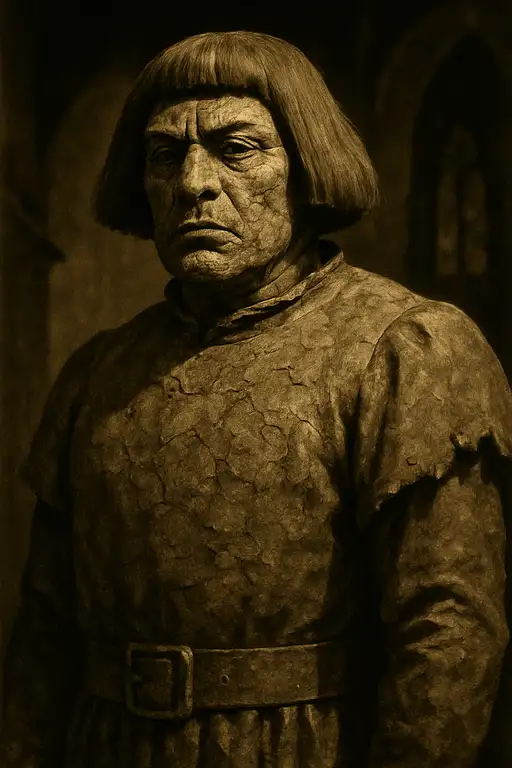
4 months ago
Create a digital illustration of the Golem as portrayed by Paul Wegener, capturing the iconic character from the 1920 film directed by Paul Wegener himself. The illustration should embody the aesthetic of 1920s cinema, characterized by its dramatic lighting, high contrast, and expressive, somewhat exaggerated features. The image must be in a 9:16 portrait format. Key elements to include: Character Design: The Golem should be depicted with a robust and imposing stature, reflecting the character's mythical and powerful nature. Emphasize the rough, clay-like texture of the Golem's skin, highlighting cracks and an earthy tone. Facial Expression: Capture the intense and somewhat sorrowful expression of the Golem, with deep-set eyes and a stern, contemplative look that conveys a sense of inner turmoil and humanity. Lighting and Shadows: Use chiaroscuro lighting to create a dramatic effect, with strong contrasts between light and dark areas. This will enhance the three-dimensional appearance and add depth to the character. Background: Incorporate elements reminiscent of early 20th-century film sets, such as gothic architecture or a dimly lit, mysterious environment that complements the eerie and timeless nature of the Golem. Costume and Details: Dress the Golem in period-appropriate attire, possibly tattered or ancient-looking robes, to further emphasize the historical context and the character's otherworldly origin. Color Palette: Utilize a sepia or monochromatic color scheme with subtle hints of color to evoke the look of early colorized films. This will help maintain the vintage feel of the 1920s cinema. Composition: Ensure the composition draws the viewer's eye to the Golem's face and upper body, making it the focal point of the image. Use the vertical format to emphasize the height and grandeur of the character. The overall aim is to create a visually striking and evocative portrait that pays homage to the classic film while incorporating the distinctive style of 1920s cinematography.
